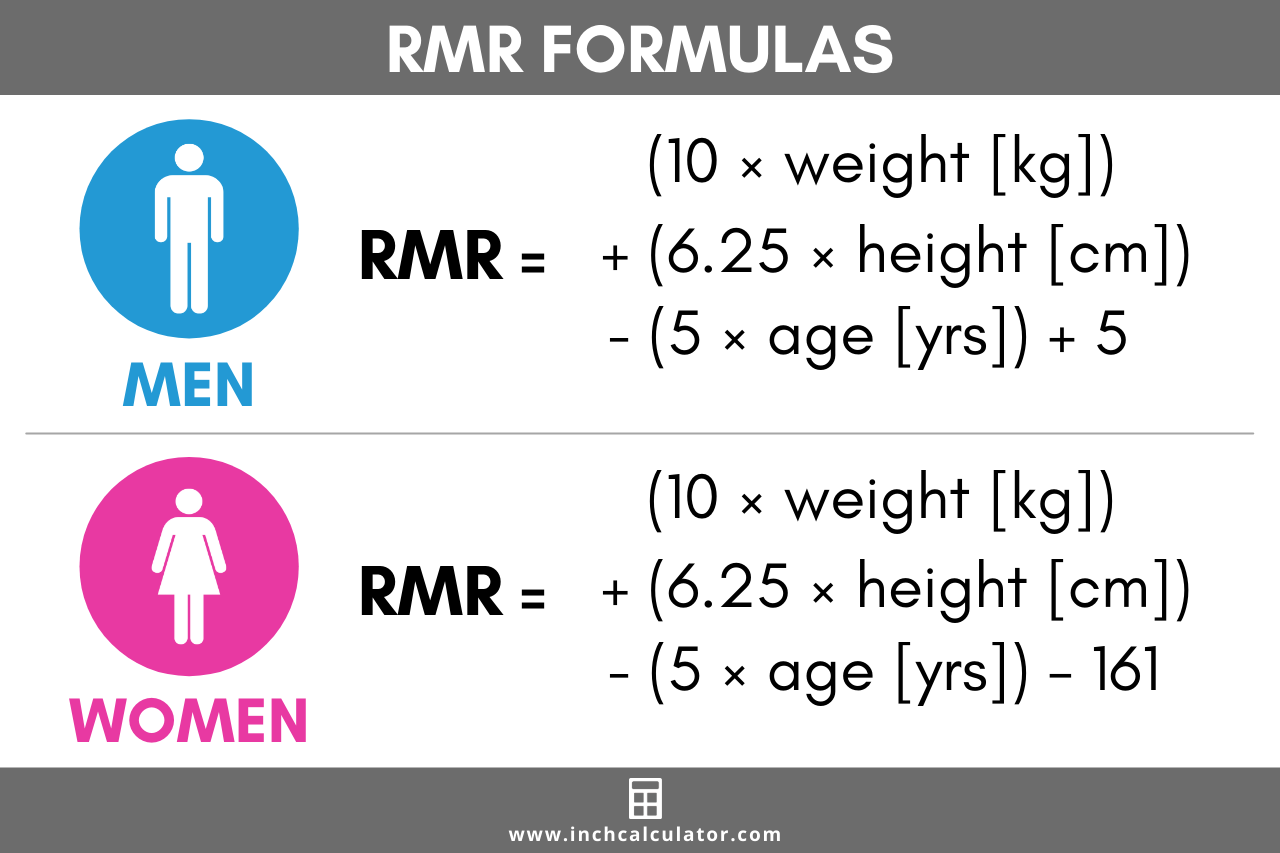RMR Calculator – Resting Metabolic Rate
Enter your age, sex, height, and weight to calculate your RMR.
Your Resting Metabolic Rate (RMR):
On this page:
Resting Metabolic Rate
Resting metabolic rate (RMR) and basal metabolic rate (BMR) are often used interchangeably to define how much energy the body uses at rest. These values are typically synonymous, however do differ very slightly.
Basal metabolic rate is the amount of energy needed during complete physical, mental, and digestive rest.[1] This amount of energy required is measured in calories.
Therefore, BMR is basically your body’s energy needs at a perfect steady state. Your true BMR would be found after a full eight hours of sleep when your body is at complete rest and not digesting food or performing other metabolic functions.[2]
Resting metabolic rate, also referred to as resting energy expenditure (REE), encompasses all of these functions, but is measured under less strict conditions. This makes it slightly less accurate than BMR.[1]
How to Calculate RMR
Determining your precise RMR can be done in a lab setting with indirect calorimetry. Unlike measuring BMR in a lab, measuring RMR can be done under less strict conditions.
For example, it does not require you to stay in a lab overnight and be measured immediately after eight hours of sleep to ensure a postabsorptive state. Therefore, it is more readily available to be measured.
However, most people do not have the ability to have indirect calorimetry performed. Therefore, formulas have been developed to estimate RMR based on your age, weight, height. More advanced formulas also use lean body mass to approximate RMR.
RMR Formulas
The Mifflin St Jeor and Cunningham equations are two formulas that have been developed to calculate RMR.

The Mifflin St Jeor equation was created in the 1990s and provided a more accurate estimate of RMR as compared to the previous Harris-Benedict equations.[3] It is more likely than other equations to estimate RMR to within 10% of that measured by indirect calorimetry.[4]
For Men:
RMR = (10 × weight [kg]) + (6.25 × height [cm]) – (5 × age [years]) + 5
For Women:
RMR = (10 × weight [kg]) + (6.25 × height [cm]) – (5 × age [years]) – 161
The Cunningham equation takes lean body mass into account when measuring resting energy expenditure.
Since skeletal muscle is more metabolically active, studies have found this equation has been shown to be more accurate in athletes or individuals with higher skeletal muscle mass.[5]
There are a couple of different ways to measure your lean body mass. If you are able to have your body fat percentage measured, the equation for lean body mass is:
LBM = (weight [kg] × 100 – body fat % / 100
You can have your body fat percentage measured in a lab setting, with skin calipers, or with specialized machines. If you do not know your body fat percentage, you can calculate lean body mass using your weight and height.
For Men:
LBM = 0.407 × weight [kg] + 0.267 × height [cm] – 19.2
For Women:
LBM = 0.252 × weight [kg] + 0.473 × height [cm] – 48.3
Once you have determined your LBM, you can then use this in the Cunningham equation to calculate your resting metabolic rate. The equation is:
RMR = 500 + (22 × LBM)
How Many Calories Do You Burn a Day?
The total amount of calories that you burn in a day is also known as total daily energy expenditure (TDEE).
This is a combination of your resting metabolic rate, daily exercise, excess post-exercise energy consumption (EPOC), non-exercise activity thermogenesis (NEAT), and the thermogenic effect of food (TEF).
The number of calories you burn at rest (RMR or resting energy expenditure) is calculated as noted above. The thermogenic effect of food is the amount of energy needed to digest your food.
This is harder to calculate and varies based on the types and amount of food consumed, but is typically about 10% of your RMR.[6]
Non-exercise activity thermogenesis is the number of calories burned while performing normal daily activities such as cooking, cleaning, walking around the house, or simply sitting at your desk.
Research has found that NEAT is a highly variable component of TDEE. However, a low level of NEAT is associated with obesity.[7]
Excess post-exercise energy consumption is extra calories your body continues to burn after a hard workout. Research shows that more intense exercises are able to promote a bigger EPOC when compared to exercises of lower intensity.[8]
To determine your TDEE, the best approach is to multiply your resting energy expenditure (or resting metabolic rate) by an activity factor, as found in the TDEE calculator. This will give an estimate of the number of calories you burn on any given day.
How Many Calories Should you Burn a Day?
If you are at your ideal weight, you should aim to burn the same amount of calories that you consume. You can calculate the approximate number of calories you will burn by calculating your total daily energy expenditure as described above.
To do this, you will need to factor in your daily activity factor in addition to your RMR.
If you are trying to lose weight, you can adjust your TDEE accordingly. If you want to lose weight, simply take the calories you would burn in a day and reduce your calorie intake by about 500 calories per day.[9] There are several other factors that will affect weight loss, but this can be a good starting point.
If you are trying to gain weight, you should increase calories by 5–15% above your total daily energy expenditure.
References
- Pethusamy, K., Gupta, A., & Yadav, R., Basal Metabolic Rate (BMR), Encyclopedia of Animal Cognition and Behavior, 2019, 1–3, https://doi.org/10.1007/978-3-319-47829-6_1429-1
- Wideman, T. H., Sullivan, M. J. L., Inada, S., McIntyre, D., Kumagai, M., Yahagi, N., Turner, J. R., Upton, J., Burns, R. J., Rothman, A. J., Michie, S., Johnston, M., Nakashima, M., Vedhara, K., Dawe, K., Wong, C., Gellman, M. D., Brimmer, D., Zielinski-Gutierrez, E., & Troxel, W., Basal Metabolic Rate, Encyclopedia of Behavioral Medicine, 2013, 176–177, https://doi.org/10.1007/978-1-4419-1005-9_377
- Mifflin, M. D., St Jeor, S. T., Hill, L. A., Scott, B. J., Daugherty, S. A., & Koh, Y. O., A new predictive equation for resting energy expenditure in healthy individuals, The American journal of clinical nutrition, 1990, 51(2), 241–247. https://doi.org/10.1093/ajcn/51.2.241
- Frankenfield, D., Roth-Yousey, L., & Compher, C., Comparison of predictive equations for resting metabolic rate in healthy nonobese and obese adults: a systematic review, Journal of the American Dietetic Association, 2005, 105(5), 775–789. https://doi.org/10.1016/j.jada.2005.02.005
- ten Haaf, T., & Weijs, P. J., Resting energy expenditure prediction in recreational athletes of 18-35 years: confirmation of Cunningham equation and an improved weight-based alternative, PloS one, 2014, 9(9), e108460. https://www.ncbi.nlm.nih.gov/pmc/articles/PMC4183531/
- Calcagno, M., Kahleova, H., Alwarith, J., Burgess, N. N., Flores, R. A., Busta, M. L., & Barnard, N. D., The thermic effect of food: a review, Journal of the American college of nutrition, 2019, 38(6), 547-551. https://www.researchgate.net/profile/Hana-Kahleova/publication/332668404_The_Thermic_Effect_of_Food_A_Review/links/5ceee7964585153c3da537a4/The-Thermic-Effect-of-Food-A-Review.pdf
- Chung, N., Park, M. Y., Kim, J., Park, H. Y., Hwang, H., Lee, C. H., Han, J. S., So, J., Park, J., & Lim, K., Non-exercise activity thermogenesis (NEAT): a component of total daily energy expenditure, Journal of exercise nutrition & biochemistry, 2018, 22(2), 23–30. https://doi.org/10.20463/jenb.2018.0013
- Foureaux, G., Pinto, K. M. D. C., & Dâmaso, A., Effects of excess post-exercise oxygen consumption and resting metabolic rate in energetic cost, Revista Brasileira de Medicina do Esporte, 2006, 12(6), 393-8. https://core.ac.uk/reader/193217590
- Koliaki, C., Spinos, T., Spinou, Μ., Brinia, Μ. E., Mitsopoulou, D., & Katsilambros, N., Defining the Optimal Dietary Approach for Safe, Effective and Sustainable Weight Loss in Overweight and Obese Adults, Healthcare (Basel, Switzerland), 2018, 6(3), 73. https://www.ncbi.nlm.nih.gov/pmc/articles/PMC6163457/


